Communication Skills and ICT Use in Health and Social Care
VerifiedAdded on 2024/05/31
|15
|5292
|481
Essay
AI Summary
This essay provides a comprehensive overview of communication within the health and social care context. It explores various communication theories, including Cognitive Dissonance and Behaviorist theories, and their application in healthcare settings. The importance of effective communication skills, such as verbal, non-verbal, and written communication, is highlighted, along with strategies to overcome barriers like physical, perceptual, and cultural differences. Furthermore, the essay discusses methods to support individuals with specific communication needs, such as using Makaton and translation devices. It also examines the influence of culture and values on the communication process, the impact of legislation and codes of practice, and the effectiveness of organizational systems in promoting good communication practices. Finally, the role and benefits of ICT in health and social care are explored, including legal considerations for its use.
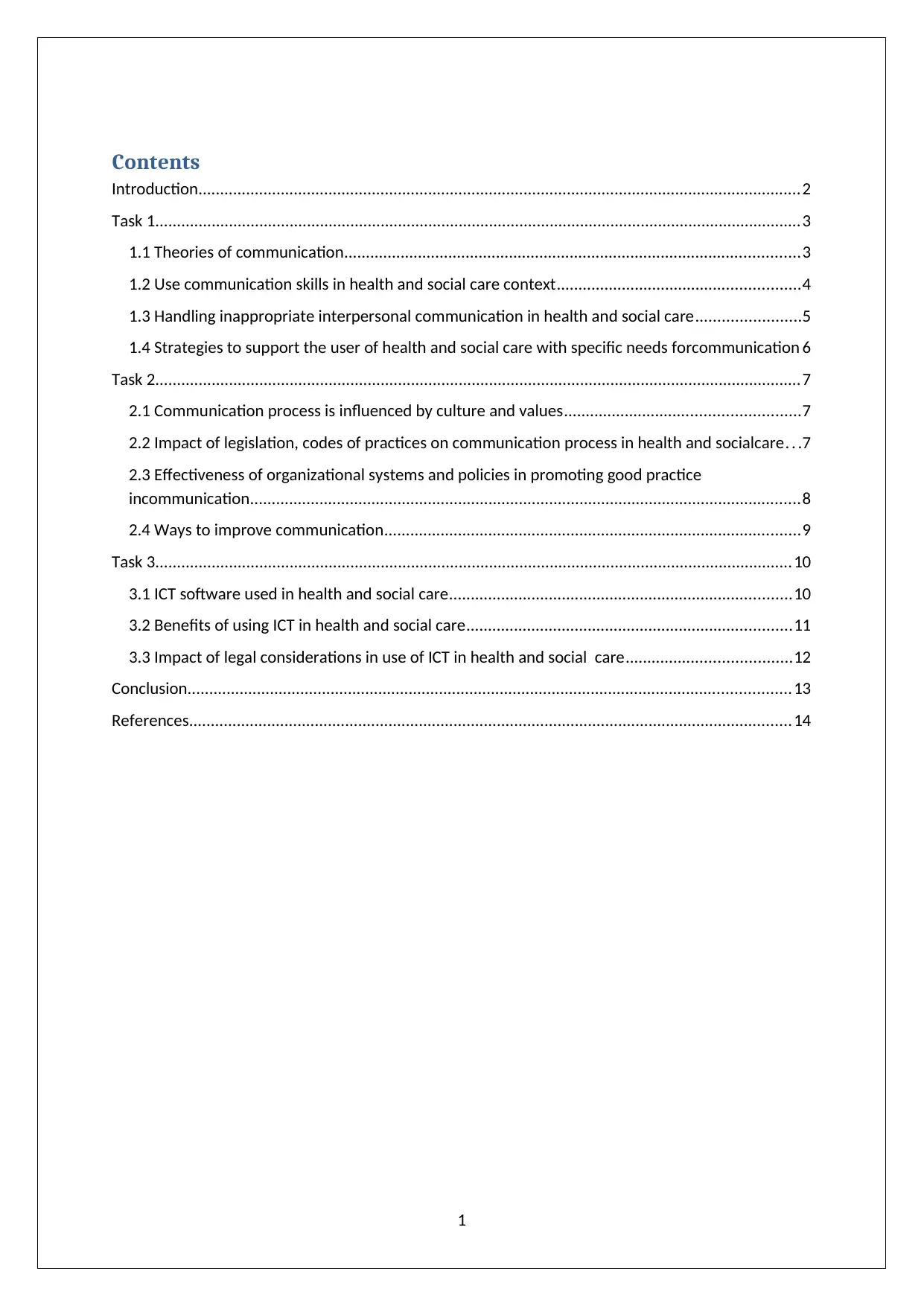
Contents
Introduction...........................................................................................................................................2
Task 1.....................................................................................................................................................3
1.1 Theories of communication.........................................................................................................3
1.2 Use communication skills in health and social care context........................................................4
1.3 Handling inappropriate interpersonal communication in health and social care........................5
1.4 Strategies to support the user of health and social care with specific needs forcommunication 6
Task 2.....................................................................................................................................................7
2.1 Communication process is influenced by culture and values......................................................7
2.2 Impact of legislation, codes of practices on communication process in health and socialcare. . .7
2.3 Effectiveness of organizational systems and policies in promoting good practice
incommunication...............................................................................................................................8
2.4 Ways to improve communication................................................................................................9
Task 3...................................................................................................................................................10
3.1 ICT software used in health and social care...............................................................................10
3.2 Benefits of using ICT in health and social care...........................................................................11
3.3 Impact of legal considerations in use of ICT in health and social care......................................12
Conclusion...........................................................................................................................................13
References...........................................................................................................................................14
1
Introduction...........................................................................................................................................2
Task 1.....................................................................................................................................................3
1.1 Theories of communication.........................................................................................................3
1.2 Use communication skills in health and social care context........................................................4
1.3 Handling inappropriate interpersonal communication in health and social care........................5
1.4 Strategies to support the user of health and social care with specific needs forcommunication 6
Task 2.....................................................................................................................................................7
2.1 Communication process is influenced by culture and values......................................................7
2.2 Impact of legislation, codes of practices on communication process in health and socialcare. . .7
2.3 Effectiveness of organizational systems and policies in promoting good practice
incommunication...............................................................................................................................8
2.4 Ways to improve communication................................................................................................9
Task 3...................................................................................................................................................10
3.1 ICT software used in health and social care...............................................................................10
3.2 Benefits of using ICT in health and social care...........................................................................11
3.3 Impact of legal considerations in use of ICT in health and social care......................................12
Conclusion...........................................................................................................................................13
References...........................................................................................................................................14
1
Paraphrase This Document
Need a fresh take? Get an instant paraphrase of this document with our AI Paraphraser
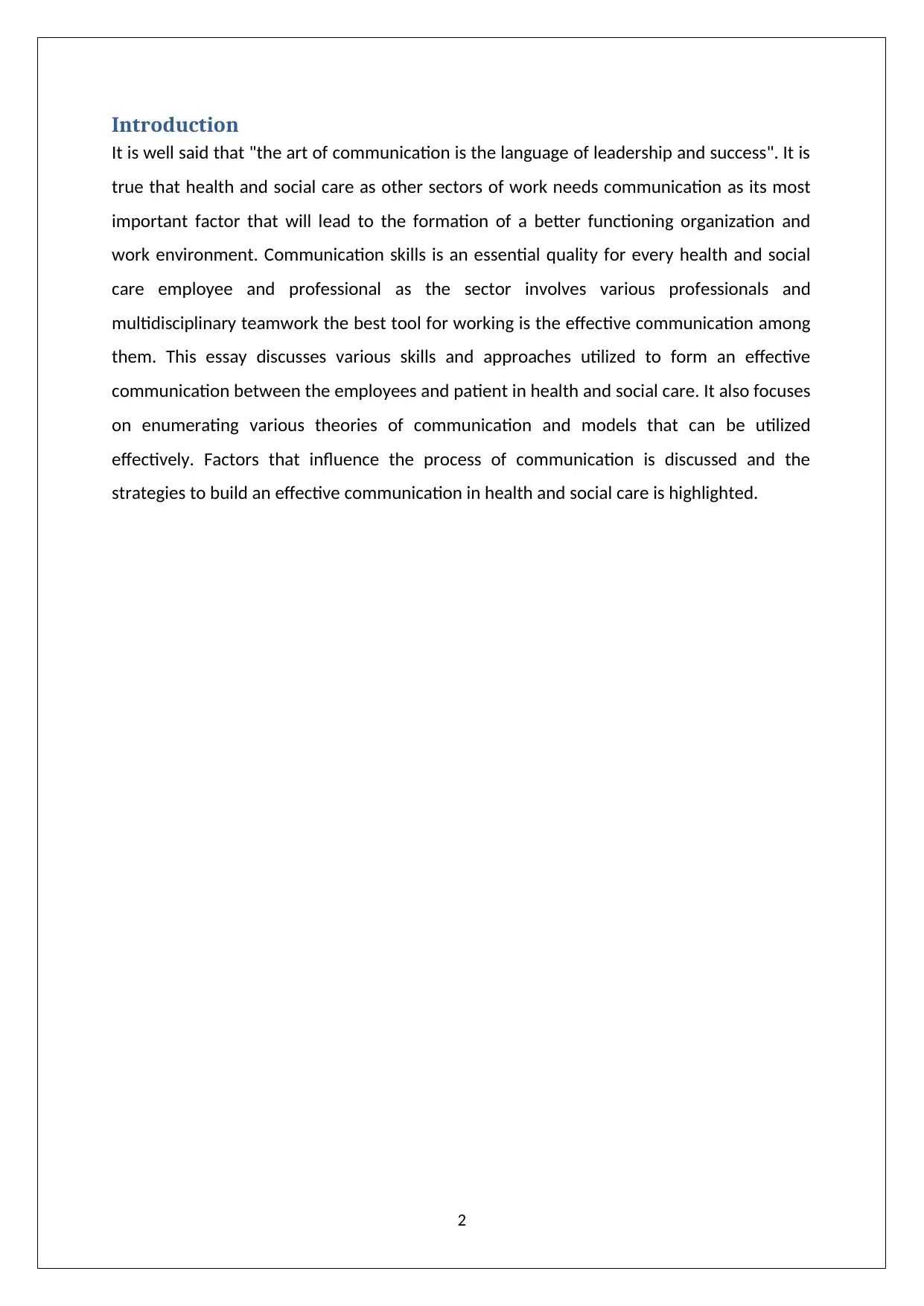
Introduction
It is well said that "the art of communication is the language of leadership and success". It is
true that health and social care as other sectors of work needs communication as its most
important factor that will lead to the formation of a better functioning organization and
work environment. Communication skills is an essential quality for every health and social
care employee and professional as the sector involves various professionals and
multidisciplinary teamwork the best tool for working is the effective communication among
them. This essay discusses various skills and approaches utilized to form an effective
communication between the employees and patient in health and social care. It also focuses
on enumerating various theories of communication and models that can be utilized
effectively. Factors that influence the process of communication is discussed and the
strategies to build an effective communication in health and social care is highlighted.
2
It is well said that "the art of communication is the language of leadership and success". It is
true that health and social care as other sectors of work needs communication as its most
important factor that will lead to the formation of a better functioning organization and
work environment. Communication skills is an essential quality for every health and social
care employee and professional as the sector involves various professionals and
multidisciplinary teamwork the best tool for working is the effective communication among
them. This essay discusses various skills and approaches utilized to form an effective
communication between the employees and patient in health and social care. It also focuses
on enumerating various theories of communication and models that can be utilized
effectively. Factors that influence the process of communication is discussed and the
strategies to build an effective communication in health and social care is highlighted.
2
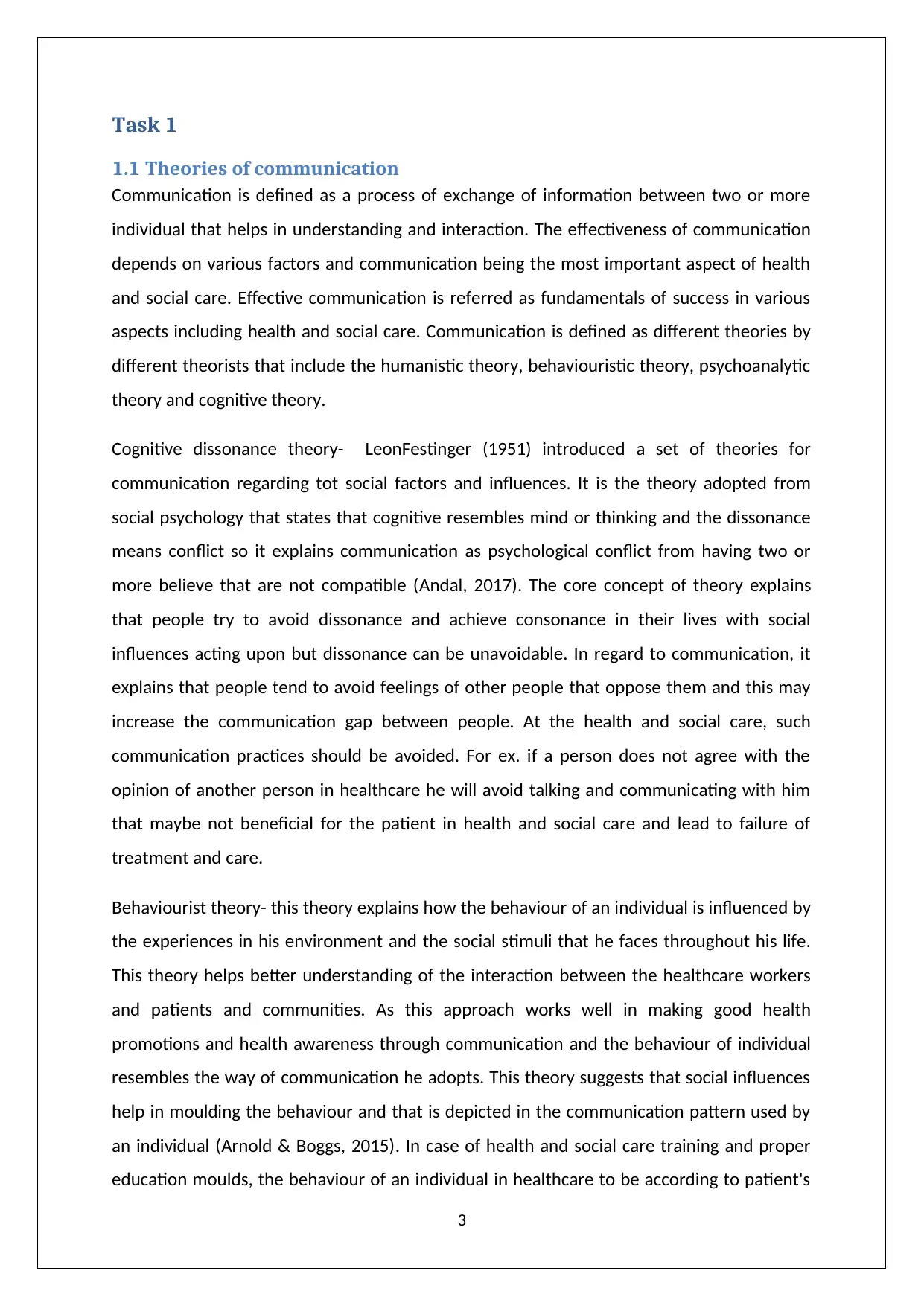
Task 1
1.1 Theories of communication
Communication is defined as a process of exchange of information between two or more
individual that helps in understanding and interaction. The effectiveness of communication
depends on various factors and communication being the most important aspect of health
and social care. Effective communication is referred as fundamentals of success in various
aspects including health and social care. Communication is defined as different theories by
different theorists that include the humanistic theory, behaviouristic theory, psychoanalytic
theory and cognitive theory.
Cognitive dissonance theory- LeonFestinger (1951) introduced a set of theories for
communication regarding tot social factors and influences. It is the theory adopted from
social psychology that states that cognitive resembles mind or thinking and the dissonance
means conflict so it explains communication as psychological conflict from having two or
more believe that are not compatible (Andal, 2017). The core concept of theory explains
that people try to avoid dissonance and achieve consonance in their lives with social
influences acting upon but dissonance can be unavoidable. In regard to communication, it
explains that people tend to avoid feelings of other people that oppose them and this may
increase the communication gap between people. At the health and social care, such
communication practices should be avoided. For ex. if a person does not agree with the
opinion of another person in healthcare he will avoid talking and communicating with him
that maybe not beneficial for the patient in health and social care and lead to failure of
treatment and care.
Behaviourist theory- this theory explains how the behaviour of an individual is influenced by
the experiences in his environment and the social stimuli that he faces throughout his life.
This theory helps better understanding of the interaction between the healthcare workers
and patients and communities. As this approach works well in making good health
promotions and health awareness through communication and the behaviour of individual
resembles the way of communication he adopts. This theory suggests that social influences
help in moulding the behaviour and that is depicted in the communication pattern used by
an individual (Arnold & Boggs, 2015). In case of health and social care training and proper
education moulds, the behaviour of an individual in healthcare to be according to patient's
3
1.1 Theories of communication
Communication is defined as a process of exchange of information between two or more
individual that helps in understanding and interaction. The effectiveness of communication
depends on various factors and communication being the most important aspect of health
and social care. Effective communication is referred as fundamentals of success in various
aspects including health and social care. Communication is defined as different theories by
different theorists that include the humanistic theory, behaviouristic theory, psychoanalytic
theory and cognitive theory.
Cognitive dissonance theory- LeonFestinger (1951) introduced a set of theories for
communication regarding tot social factors and influences. It is the theory adopted from
social psychology that states that cognitive resembles mind or thinking and the dissonance
means conflict so it explains communication as psychological conflict from having two or
more believe that are not compatible (Andal, 2017). The core concept of theory explains
that people try to avoid dissonance and achieve consonance in their lives with social
influences acting upon but dissonance can be unavoidable. In regard to communication, it
explains that people tend to avoid feelings of other people that oppose them and this may
increase the communication gap between people. At the health and social care, such
communication practices should be avoided. For ex. if a person does not agree with the
opinion of another person in healthcare he will avoid talking and communicating with him
that maybe not beneficial for the patient in health and social care and lead to failure of
treatment and care.
Behaviourist theory- this theory explains how the behaviour of an individual is influenced by
the experiences in his environment and the social stimuli that he faces throughout his life.
This theory helps better understanding of the interaction between the healthcare workers
and patients and communities. As this approach works well in making good health
promotions and health awareness through communication and the behaviour of individual
resembles the way of communication he adopts. This theory suggests that social influences
help in moulding the behaviour and that is depicted in the communication pattern used by
an individual (Arnold & Boggs, 2015). In case of health and social care training and proper
education moulds, the behaviour of an individual in healthcare to be according to patient's
3
⊘ This is a preview!⊘
Do you want full access?
Subscribe today to unlock all pages.

Trusted by 1+ million students worldwide
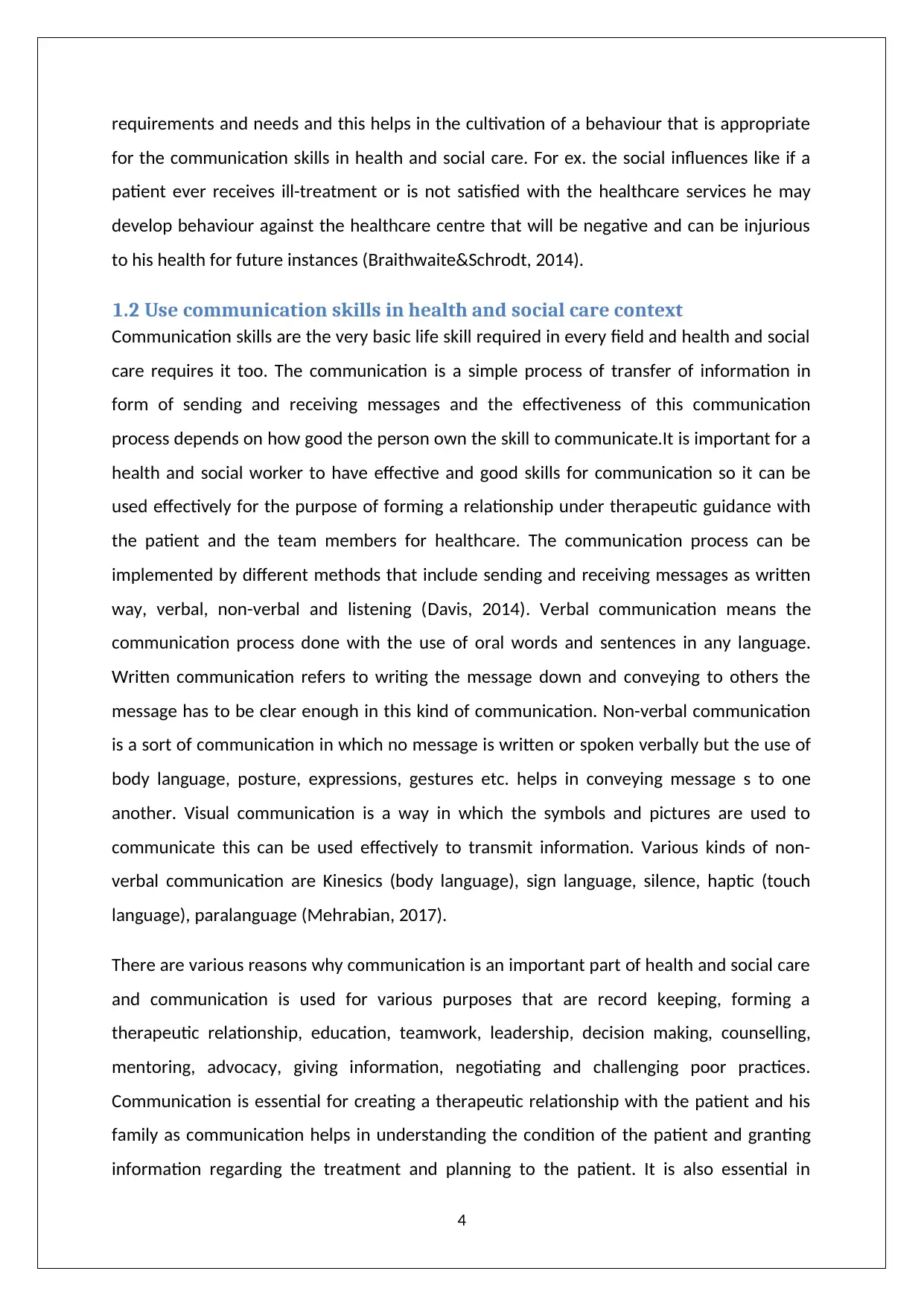
requirements and needs and this helps in the cultivation of a behaviour that is appropriate
for the communication skills in health and social care. For ex. the social influences like if a
patient ever receives ill-treatment or is not satisfied with the healthcare services he may
develop behaviour against the healthcare centre that will be negative and can be injurious
to his health for future instances (Braithwaite&Schrodt, 2014).
1.2 Use communication skills in health and social care context
Communication skills are the very basic life skill required in every field and health and social
care requires it too. The communication is a simple process of transfer of information in
form of sending and receiving messages and the effectiveness of this communication
process depends on how good the person own the skill to communicate.It is important for a
health and social worker to have effective and good skills for communication so it can be
used effectively for the purpose of forming a relationship under therapeutic guidance with
the patient and the team members for healthcare. The communication process can be
implemented by different methods that include sending and receiving messages as written
way, verbal, non-verbal and listening (Davis, 2014). Verbal communication means the
communication process done with the use of oral words and sentences in any language.
Written communication refers to writing the message down and conveying to others the
message has to be clear enough in this kind of communication. Non-verbal communication
is a sort of communication in which no message is written or spoken verbally but the use of
body language, posture, expressions, gestures etc. helps in conveying message s to one
another. Visual communication is a way in which the symbols and pictures are used to
communicate this can be used effectively to transmit information. Various kinds of non-
verbal communication are Kinesics (body language), sign language, silence, haptic (touch
language), paralanguage (Mehrabian, 2017).
There are various reasons why communication is an important part of health and social care
and communication is used for various purposes that are record keeping, forming a
therapeutic relationship, education, teamwork, leadership, decision making, counselling,
mentoring, advocacy, giving information, negotiating and challenging poor practices.
Communication is essential for creating a therapeutic relationship with the patient and his
family as communication helps in understanding the condition of the patient and granting
information regarding the treatment and planning to the patient. It is also essential in
4
for the communication skills in health and social care. For ex. the social influences like if a
patient ever receives ill-treatment or is not satisfied with the healthcare services he may
develop behaviour against the healthcare centre that will be negative and can be injurious
to his health for future instances (Braithwaite&Schrodt, 2014).
1.2 Use communication skills in health and social care context
Communication skills are the very basic life skill required in every field and health and social
care requires it too. The communication is a simple process of transfer of information in
form of sending and receiving messages and the effectiveness of this communication
process depends on how good the person own the skill to communicate.It is important for a
health and social worker to have effective and good skills for communication so it can be
used effectively for the purpose of forming a relationship under therapeutic guidance with
the patient and the team members for healthcare. The communication process can be
implemented by different methods that include sending and receiving messages as written
way, verbal, non-verbal and listening (Davis, 2014). Verbal communication means the
communication process done with the use of oral words and sentences in any language.
Written communication refers to writing the message down and conveying to others the
message has to be clear enough in this kind of communication. Non-verbal communication
is a sort of communication in which no message is written or spoken verbally but the use of
body language, posture, expressions, gestures etc. helps in conveying message s to one
another. Visual communication is a way in which the symbols and pictures are used to
communicate this can be used effectively to transmit information. Various kinds of non-
verbal communication are Kinesics (body language), sign language, silence, haptic (touch
language), paralanguage (Mehrabian, 2017).
There are various reasons why communication is an important part of health and social care
and communication is used for various purposes that are record keeping, forming a
therapeutic relationship, education, teamwork, leadership, decision making, counselling,
mentoring, advocacy, giving information, negotiating and challenging poor practices.
Communication is essential for creating a therapeutic relationship with the patient and his
family as communication helps in understanding the condition of the patient and granting
information regarding the treatment and planning to the patient. It is also essential in
4
Paraphrase This Document
Need a fresh take? Get an instant paraphrase of this document with our AI Paraphraser
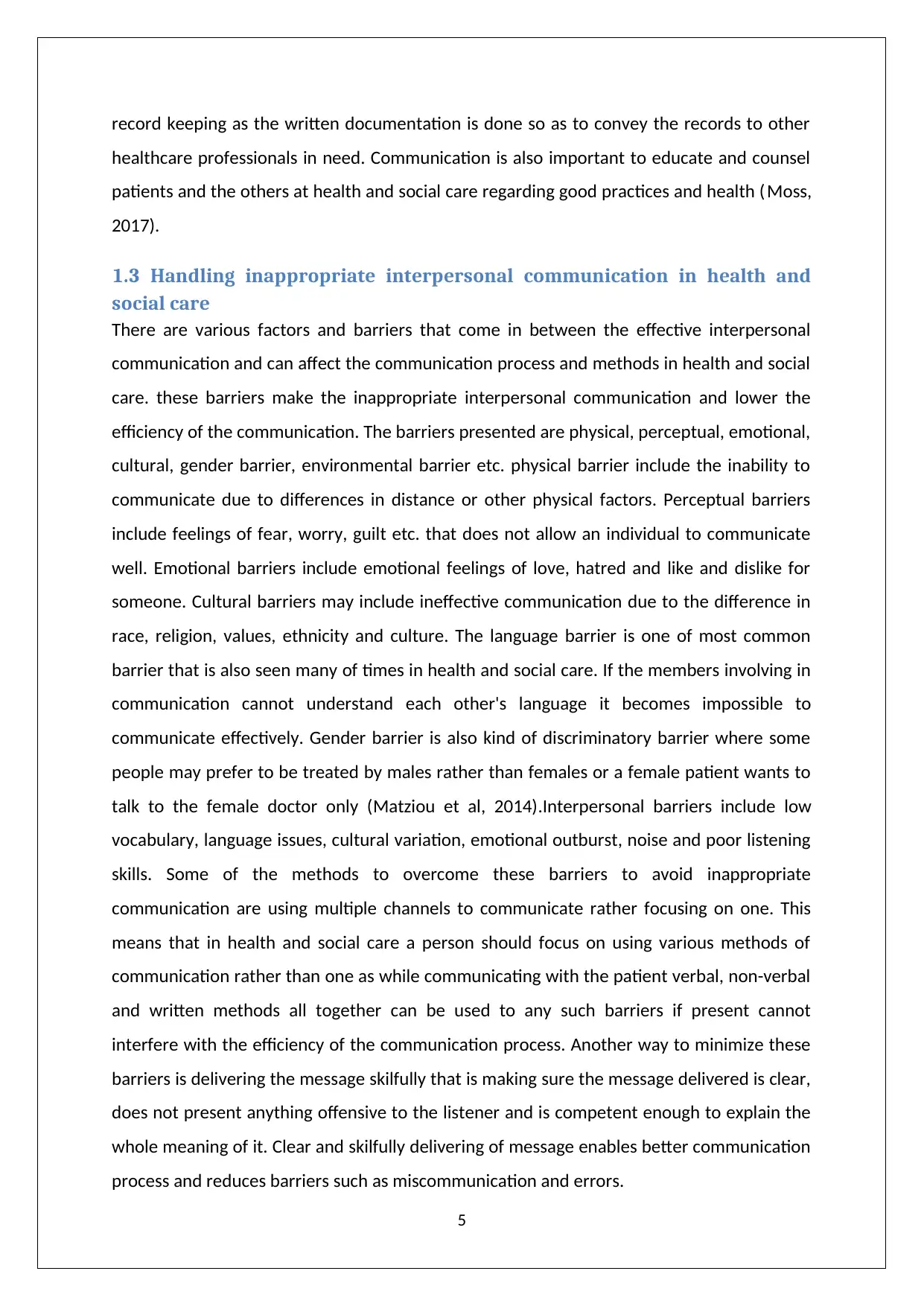
record keeping as the written documentation is done so as to convey the records to other
healthcare professionals in need. Communication is also important to educate and counsel
patients and the others at health and social care regarding good practices and health ( Moss,
2017).
1.3 Handling inappropriate interpersonal communication in health and
social care
There are various factors and barriers that come in between the effective interpersonal
communication and can affect the communication process and methods in health and social
care. these barriers make the inappropriate interpersonal communication and lower the
efficiency of the communication. The barriers presented are physical, perceptual, emotional,
cultural, gender barrier, environmental barrier etc. physical barrier include the inability to
communicate due to differences in distance or other physical factors. Perceptual barriers
include feelings of fear, worry, guilt etc. that does not allow an individual to communicate
well. Emotional barriers include emotional feelings of love, hatred and like and dislike for
someone. Cultural barriers may include ineffective communication due to the difference in
race, religion, values, ethnicity and culture. The language barrier is one of most common
barrier that is also seen many of times in health and social care. If the members involving in
communication cannot understand each other's language it becomes impossible to
communicate effectively. Gender barrier is also kind of discriminatory barrier where some
people may prefer to be treated by males rather than females or a female patient wants to
talk to the female doctor only (Matziou et al, 2014).Interpersonal barriers include low
vocabulary, language issues, cultural variation, emotional outburst, noise and poor listening
skills. Some of the methods to overcome these barriers to avoid inappropriate
communication are using multiple channels to communicate rather focusing on one. This
means that in health and social care a person should focus on using various methods of
communication rather than one as while communicating with the patient verbal, non-verbal
and written methods all together can be used to any such barriers if present cannot
interfere with the efficiency of the communication process. Another way to minimize these
barriers is delivering the message skilfully that is making sure the message delivered is clear,
does not present anything offensive to the listener and is competent enough to explain the
whole meaning of it. Clear and skilfully delivering of message enables better communication
process and reduces barriers such as miscommunication and errors.
5
healthcare professionals in need. Communication is also important to educate and counsel
patients and the others at health and social care regarding good practices and health ( Moss,
2017).
1.3 Handling inappropriate interpersonal communication in health and
social care
There are various factors and barriers that come in between the effective interpersonal
communication and can affect the communication process and methods in health and social
care. these barriers make the inappropriate interpersonal communication and lower the
efficiency of the communication. The barriers presented are physical, perceptual, emotional,
cultural, gender barrier, environmental barrier etc. physical barrier include the inability to
communicate due to differences in distance or other physical factors. Perceptual barriers
include feelings of fear, worry, guilt etc. that does not allow an individual to communicate
well. Emotional barriers include emotional feelings of love, hatred and like and dislike for
someone. Cultural barriers may include ineffective communication due to the difference in
race, religion, values, ethnicity and culture. The language barrier is one of most common
barrier that is also seen many of times in health and social care. If the members involving in
communication cannot understand each other's language it becomes impossible to
communicate effectively. Gender barrier is also kind of discriminatory barrier where some
people may prefer to be treated by males rather than females or a female patient wants to
talk to the female doctor only (Matziou et al, 2014).Interpersonal barriers include low
vocabulary, language issues, cultural variation, emotional outburst, noise and poor listening
skills. Some of the methods to overcome these barriers to avoid inappropriate
communication are using multiple channels to communicate rather focusing on one. This
means that in health and social care a person should focus on using various methods of
communication rather than one as while communicating with the patient verbal, non-verbal
and written methods all together can be used to any such barriers if present cannot
interfere with the efficiency of the communication process. Another way to minimize these
barriers is delivering the message skilfully that is making sure the message delivered is clear,
does not present anything offensive to the listener and is competent enough to explain the
whole meaning of it. Clear and skilfully delivering of message enables better communication
process and reduces barriers such as miscommunication and errors.
5
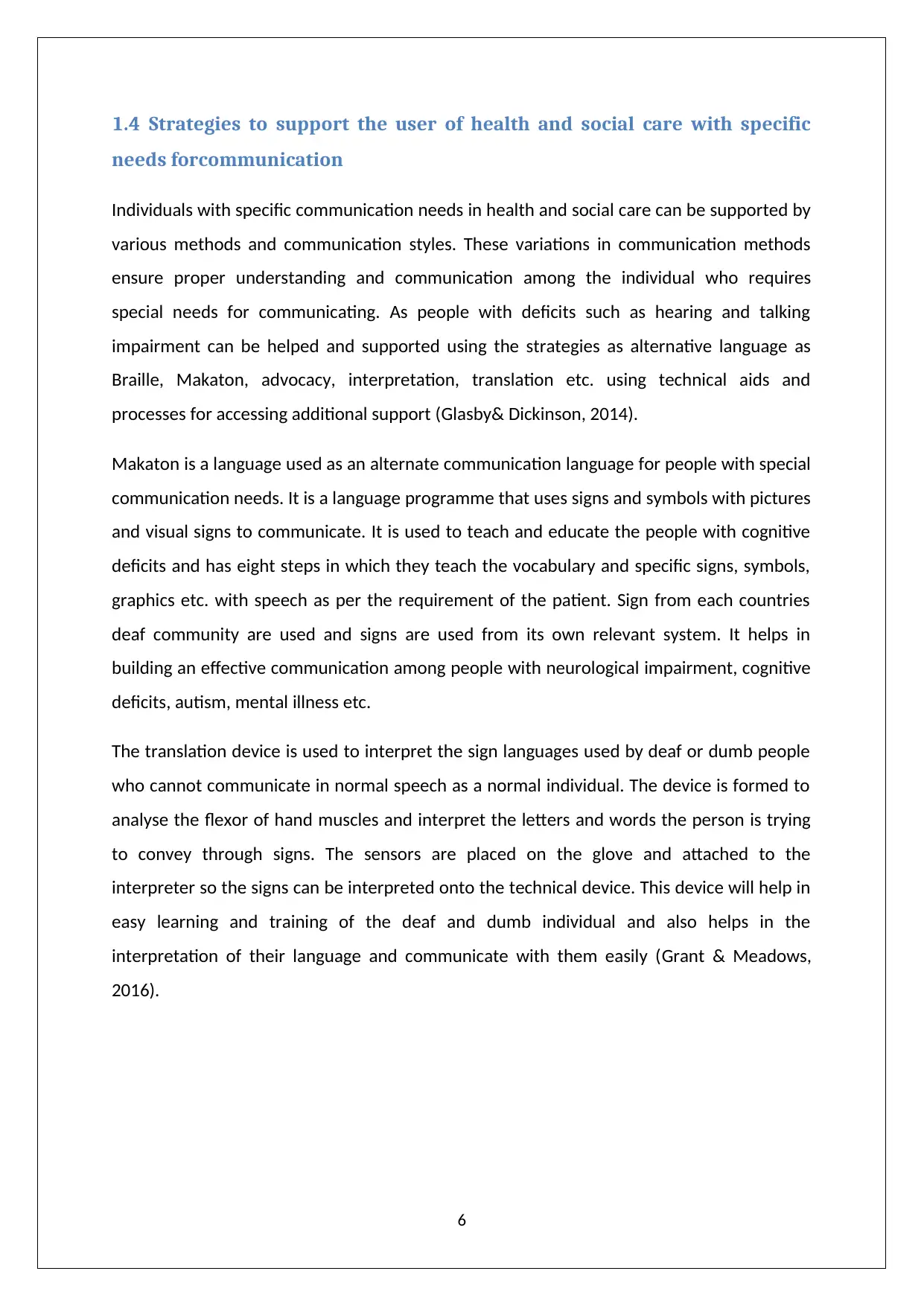
1.4 Strategies to support the user of health and social care with specific
needs forcommunication
Individuals with specific communication needs in health and social care can be supported by
various methods and communication styles. These variations in communication methods
ensure proper understanding and communication among the individual who requires
special needs for communicating. As people with deficits such as hearing and talking
impairment can be helped and supported using the strategies as alternative language as
Braille, Makaton, advocacy, interpretation, translation etc. using technical aids and
processes for accessing additional support (Glasby& Dickinson, 2014).
Makaton is a language used as an alternate communication language for people with special
communication needs. It is a language programme that uses signs and symbols with pictures
and visual signs to communicate. It is used to teach and educate the people with cognitive
deficits and has eight steps in which they teach the vocabulary and specific signs, symbols,
graphics etc. with speech as per the requirement of the patient. Sign from each countries
deaf community are used and signs are used from its own relevant system. It helps in
building an effective communication among people with neurological impairment, cognitive
deficits, autism, mental illness etc.
The translation device is used to interpret the sign languages used by deaf or dumb people
who cannot communicate in normal speech as a normal individual. The device is formed to
analyse the flexor of hand muscles and interpret the letters and words the person is trying
to convey through signs. The sensors are placed on the glove and attached to the
interpreter so the signs can be interpreted onto the technical device. This device will help in
easy learning and training of the deaf and dumb individual and also helps in the
interpretation of their language and communicate with them easily (Grant & Meadows,
2016).
6
needs forcommunication
Individuals with specific communication needs in health and social care can be supported by
various methods and communication styles. These variations in communication methods
ensure proper understanding and communication among the individual who requires
special needs for communicating. As people with deficits such as hearing and talking
impairment can be helped and supported using the strategies as alternative language as
Braille, Makaton, advocacy, interpretation, translation etc. using technical aids and
processes for accessing additional support (Glasby& Dickinson, 2014).
Makaton is a language used as an alternate communication language for people with special
communication needs. It is a language programme that uses signs and symbols with pictures
and visual signs to communicate. It is used to teach and educate the people with cognitive
deficits and has eight steps in which they teach the vocabulary and specific signs, symbols,
graphics etc. with speech as per the requirement of the patient. Sign from each countries
deaf community are used and signs are used from its own relevant system. It helps in
building an effective communication among people with neurological impairment, cognitive
deficits, autism, mental illness etc.
The translation device is used to interpret the sign languages used by deaf or dumb people
who cannot communicate in normal speech as a normal individual. The device is formed to
analyse the flexor of hand muscles and interpret the letters and words the person is trying
to convey through signs. The sensors are placed on the glove and attached to the
interpreter so the signs can be interpreted onto the technical device. This device will help in
easy learning and training of the deaf and dumb individual and also helps in the
interpretation of their language and communicate with them easily (Grant & Meadows,
2016).
6
⊘ This is a preview!⊘
Do you want full access?
Subscribe today to unlock all pages.

Trusted by 1+ million students worldwide
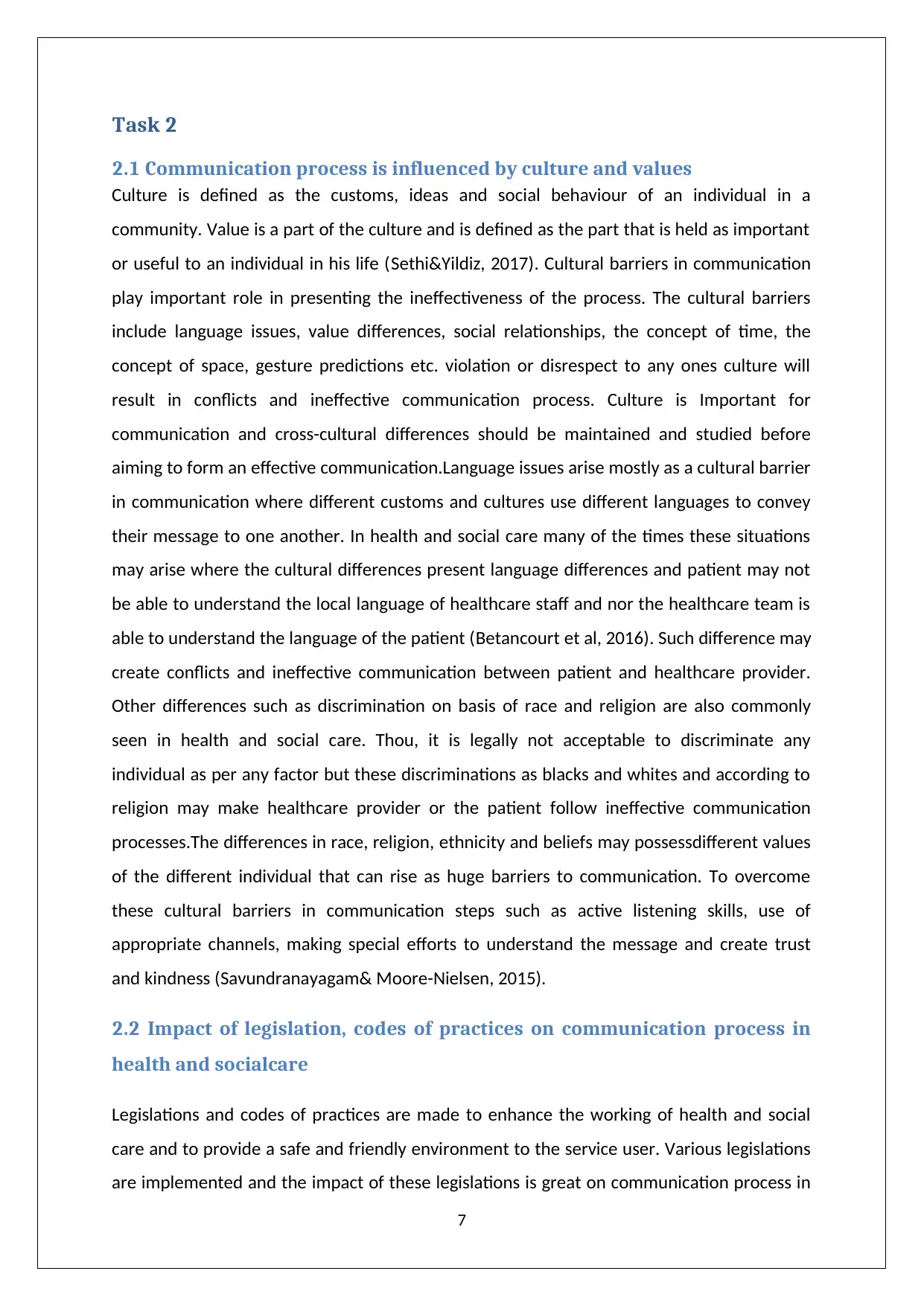
Task 2
2.1 Communication process is influenced by culture and values
Culture is defined as the customs, ideas and social behaviour of an individual in a
community. Value is a part of the culture and is defined as the part that is held as important
or useful to an individual in his life (Sethi&Yildiz, 2017). Cultural barriers in communication
play important role in presenting the ineffectiveness of the process. The cultural barriers
include language issues, value differences, social relationships, the concept of time, the
concept of space, gesture predictions etc. violation or disrespect to any ones culture will
result in conflicts and ineffective communication process. Culture is Important for
communication and cross-cultural differences should be maintained and studied before
aiming to form an effective communication.Language issues arise mostly as a cultural barrier
in communication where different customs and cultures use different languages to convey
their message to one another. In health and social care many of the times these situations
may arise where the cultural differences present language differences and patient may not
be able to understand the local language of healthcare staff and nor the healthcare team is
able to understand the language of the patient (Betancourt et al, 2016). Such difference may
create conflicts and ineffective communication between patient and healthcare provider.
Other differences such as discrimination on basis of race and religion are also commonly
seen in health and social care. Thou, it is legally not acceptable to discriminate any
individual as per any factor but these discriminations as blacks and whites and according to
religion may make healthcare provider or the patient follow ineffective communication
processes.The differences in race, religion, ethnicity and beliefs may possessdifferent values
of the different individual that can rise as huge barriers to communication. To overcome
these cultural barriers in communication steps such as active listening skills, use of
appropriate channels, making special efforts to understand the message and create trust
and kindness (Savundranayagam& Moore-Nielsen, 2015).
2.2 Impact of legislation, codes of practices on communication process in
health and socialcare
Legislations and codes of practices are made to enhance the working of health and social
care and to provide a safe and friendly environment to the service user. Various legislations
are implemented and the impact of these legislations is great on communication process in
7
2.1 Communication process is influenced by culture and values
Culture is defined as the customs, ideas and social behaviour of an individual in a
community. Value is a part of the culture and is defined as the part that is held as important
or useful to an individual in his life (Sethi&Yildiz, 2017). Cultural barriers in communication
play important role in presenting the ineffectiveness of the process. The cultural barriers
include language issues, value differences, social relationships, the concept of time, the
concept of space, gesture predictions etc. violation or disrespect to any ones culture will
result in conflicts and ineffective communication process. Culture is Important for
communication and cross-cultural differences should be maintained and studied before
aiming to form an effective communication.Language issues arise mostly as a cultural barrier
in communication where different customs and cultures use different languages to convey
their message to one another. In health and social care many of the times these situations
may arise where the cultural differences present language differences and patient may not
be able to understand the local language of healthcare staff and nor the healthcare team is
able to understand the language of the patient (Betancourt et al, 2016). Such difference may
create conflicts and ineffective communication between patient and healthcare provider.
Other differences such as discrimination on basis of race and religion are also commonly
seen in health and social care. Thou, it is legally not acceptable to discriminate any
individual as per any factor but these discriminations as blacks and whites and according to
religion may make healthcare provider or the patient follow ineffective communication
processes.The differences in race, religion, ethnicity and beliefs may possessdifferent values
of the different individual that can rise as huge barriers to communication. To overcome
these cultural barriers in communication steps such as active listening skills, use of
appropriate channels, making special efforts to understand the message and create trust
and kindness (Savundranayagam& Moore-Nielsen, 2015).
2.2 Impact of legislation, codes of practices on communication process in
health and socialcare
Legislations and codes of practices are made to enhance the working of health and social
care and to provide a safe and friendly environment to the service user. Various legislations
are implemented and the impact of these legislations is great on communication process in
7
Paraphrase This Document
Need a fresh take? Get an instant paraphrase of this document with our AI Paraphraser
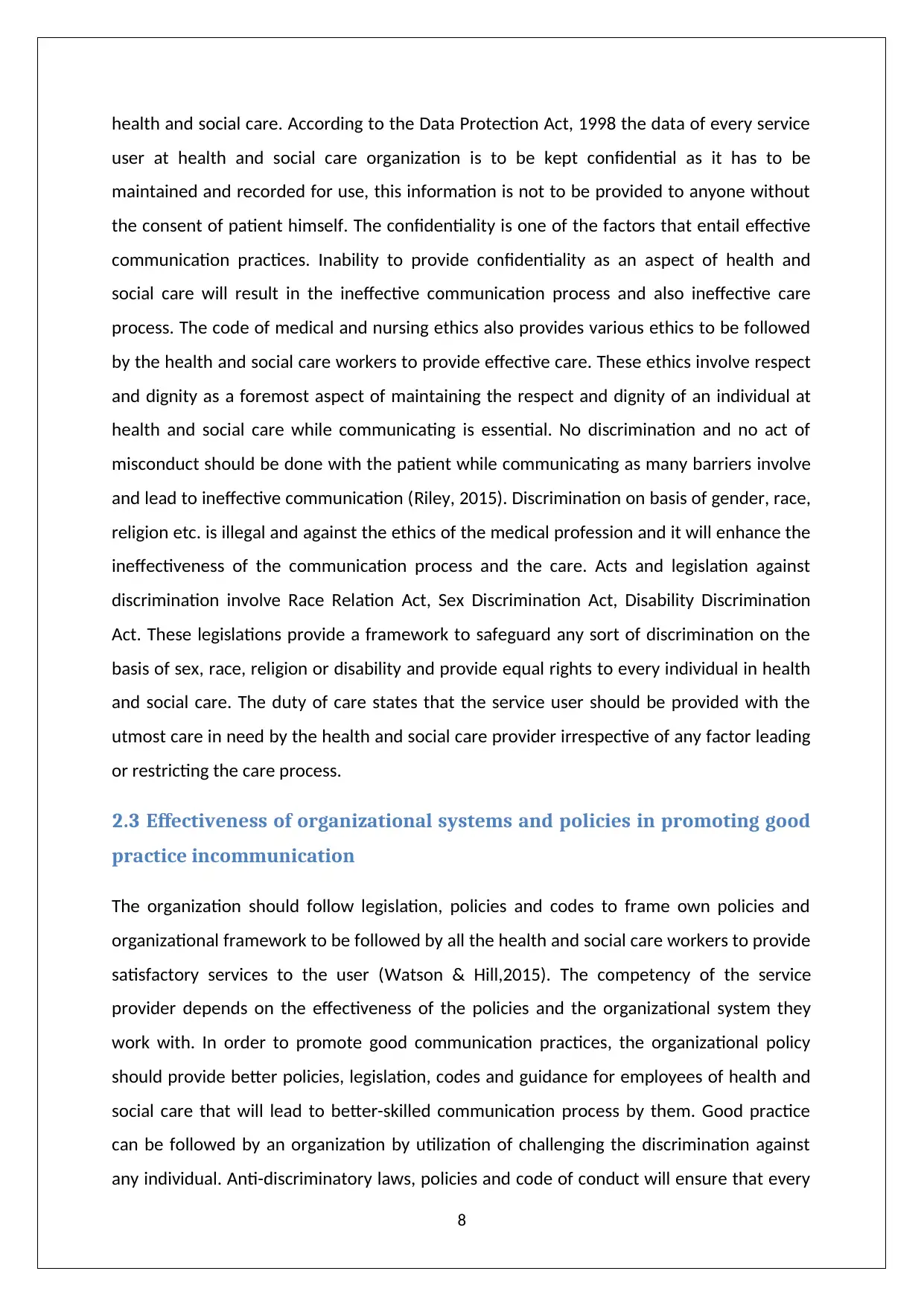
health and social care. According to the Data Protection Act, 1998 the data of every service
user at health and social care organization is to be kept confidential as it has to be
maintained and recorded for use, this information is not to be provided to anyone without
the consent of patient himself. The confidentiality is one of the factors that entail effective
communication practices. Inability to provide confidentiality as an aspect of health and
social care will result in the ineffective communication process and also ineffective care
process. The code of medical and nursing ethics also provides various ethics to be followed
by the health and social care workers to provide effective care. These ethics involve respect
and dignity as a foremost aspect of maintaining the respect and dignity of an individual at
health and social care while communicating is essential. No discrimination and no act of
misconduct should be done with the patient while communicating as many barriers involve
and lead to ineffective communication (Riley, 2015). Discrimination on basis of gender, race,
religion etc. is illegal and against the ethics of the medical profession and it will enhance the
ineffectiveness of the communication process and the care. Acts and legislation against
discrimination involve Race Relation Act, Sex Discrimination Act, Disability Discrimination
Act. These legislations provide a framework to safeguard any sort of discrimination on the
basis of sex, race, religion or disability and provide equal rights to every individual in health
and social care. The duty of care states that the service user should be provided with the
utmost care in need by the health and social care provider irrespective of any factor leading
or restricting the care process.
2.3 Effectiveness of organizational systems and policies in promoting good
practice incommunication
The organization should follow legislation, policies and codes to frame own policies and
organizational framework to be followed by all the health and social care workers to provide
satisfactory services to the user (Watson & Hill,2015). The competency of the service
provider depends on the effectiveness of the policies and the organizational system they
work with. In order to promote good communication practices, the organizational policy
should provide better policies, legislation, codes and guidance for employees of health and
social care that will lead to better-skilled communication process by them. Good practice
can be followed by an organization by utilization of challenging the discrimination against
any individual. Anti-discriminatory laws, policies and code of conduct will ensure that every
8
user at health and social care organization is to be kept confidential as it has to be
maintained and recorded for use, this information is not to be provided to anyone without
the consent of patient himself. The confidentiality is one of the factors that entail effective
communication practices. Inability to provide confidentiality as an aspect of health and
social care will result in the ineffective communication process and also ineffective care
process. The code of medical and nursing ethics also provides various ethics to be followed
by the health and social care workers to provide effective care. These ethics involve respect
and dignity as a foremost aspect of maintaining the respect and dignity of an individual at
health and social care while communicating is essential. No discrimination and no act of
misconduct should be done with the patient while communicating as many barriers involve
and lead to ineffective communication (Riley, 2015). Discrimination on basis of gender, race,
religion etc. is illegal and against the ethics of the medical profession and it will enhance the
ineffectiveness of the communication process and the care. Acts and legislation against
discrimination involve Race Relation Act, Sex Discrimination Act, Disability Discrimination
Act. These legislations provide a framework to safeguard any sort of discrimination on the
basis of sex, race, religion or disability and provide equal rights to every individual in health
and social care. The duty of care states that the service user should be provided with the
utmost care in need by the health and social care provider irrespective of any factor leading
or restricting the care process.
2.3 Effectiveness of organizational systems and policies in promoting good
practice incommunication
The organization should follow legislation, policies and codes to frame own policies and
organizational framework to be followed by all the health and social care workers to provide
satisfactory services to the user (Watson & Hill,2015). The competency of the service
provider depends on the effectiveness of the policies and the organizational system they
work with. In order to promote good communication practices, the organizational policy
should provide better policies, legislation, codes and guidance for employees of health and
social care that will lead to better-skilled communication process by them. Good practice
can be followed by an organization by utilization of challenging the discrimination against
any individual. Anti-discriminatory laws, policies and code of conduct will ensure that every
8
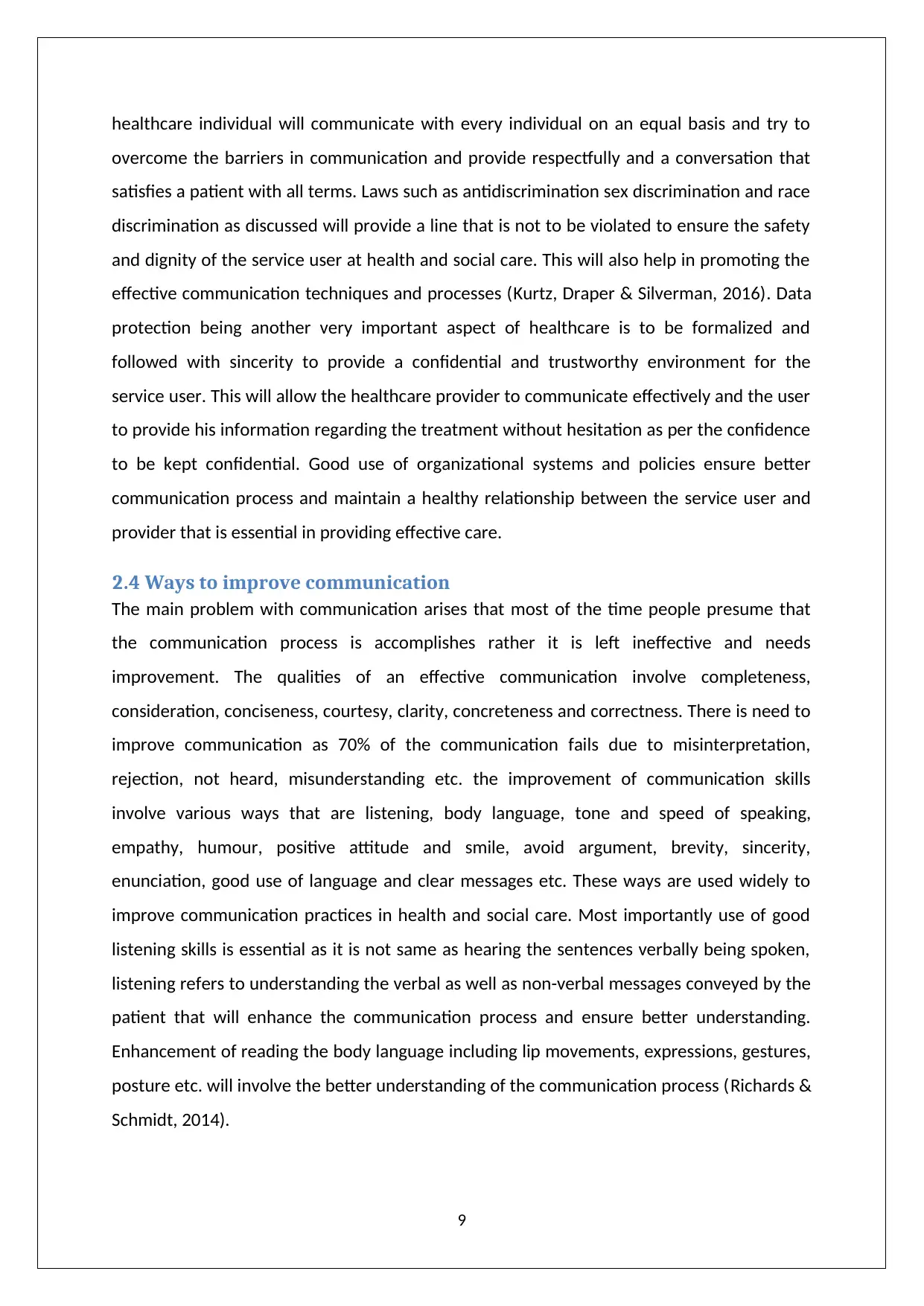
healthcare individual will communicate with every individual on an equal basis and try to
overcome the barriers in communication and provide respectfully and a conversation that
satisfies a patient with all terms. Laws such as antidiscrimination sex discrimination and race
discrimination as discussed will provide a line that is not to be violated to ensure the safety
and dignity of the service user at health and social care. This will also help in promoting the
effective communication techniques and processes (Kurtz, Draper & Silverman, 2016). Data
protection being another very important aspect of healthcare is to be formalized and
followed with sincerity to provide a confidential and trustworthy environment for the
service user. This will allow the healthcare provider to communicate effectively and the user
to provide his information regarding the treatment without hesitation as per the confidence
to be kept confidential. Good use of organizational systems and policies ensure better
communication process and maintain a healthy relationship between the service user and
provider that is essential in providing effective care.
2.4 Ways to improve communication
The main problem with communication arises that most of the time people presume that
the communication process is accomplishes rather it is left ineffective and needs
improvement. The qualities of an effective communication involve completeness,
consideration, conciseness, courtesy, clarity, concreteness and correctness. There is need to
improve communication as 70% of the communication fails due to misinterpretation,
rejection, not heard, misunderstanding etc. the improvement of communication skills
involve various ways that are listening, body language, tone and speed of speaking,
empathy, humour, positive attitude and smile, avoid argument, brevity, sincerity,
enunciation, good use of language and clear messages etc. These ways are used widely to
improve communication practices in health and social care. Most importantly use of good
listening skills is essential as it is not same as hearing the sentences verbally being spoken,
listening refers to understanding the verbal as well as non-verbal messages conveyed by the
patient that will enhance the communication process and ensure better understanding.
Enhancement of reading the body language including lip movements, expressions, gestures,
posture etc. will involve the better understanding of the communication process (Richards &
Schmidt, 2014).
9
overcome the barriers in communication and provide respectfully and a conversation that
satisfies a patient with all terms. Laws such as antidiscrimination sex discrimination and race
discrimination as discussed will provide a line that is not to be violated to ensure the safety
and dignity of the service user at health and social care. This will also help in promoting the
effective communication techniques and processes (Kurtz, Draper & Silverman, 2016). Data
protection being another very important aspect of healthcare is to be formalized and
followed with sincerity to provide a confidential and trustworthy environment for the
service user. This will allow the healthcare provider to communicate effectively and the user
to provide his information regarding the treatment without hesitation as per the confidence
to be kept confidential. Good use of organizational systems and policies ensure better
communication process and maintain a healthy relationship between the service user and
provider that is essential in providing effective care.
2.4 Ways to improve communication
The main problem with communication arises that most of the time people presume that
the communication process is accomplishes rather it is left ineffective and needs
improvement. The qualities of an effective communication involve completeness,
consideration, conciseness, courtesy, clarity, concreteness and correctness. There is need to
improve communication as 70% of the communication fails due to misinterpretation,
rejection, not heard, misunderstanding etc. the improvement of communication skills
involve various ways that are listening, body language, tone and speed of speaking,
empathy, humour, positive attitude and smile, avoid argument, brevity, sincerity,
enunciation, good use of language and clear messages etc. These ways are used widely to
improve communication practices in health and social care. Most importantly use of good
listening skills is essential as it is not same as hearing the sentences verbally being spoken,
listening refers to understanding the verbal as well as non-verbal messages conveyed by the
patient that will enhance the communication process and ensure better understanding.
Enhancement of reading the body language including lip movements, expressions, gestures,
posture etc. will involve the better understanding of the communication process (Richards &
Schmidt, 2014).
9
⊘ This is a preview!⊘
Do you want full access?
Subscribe today to unlock all pages.

Trusted by 1+ million students worldwide
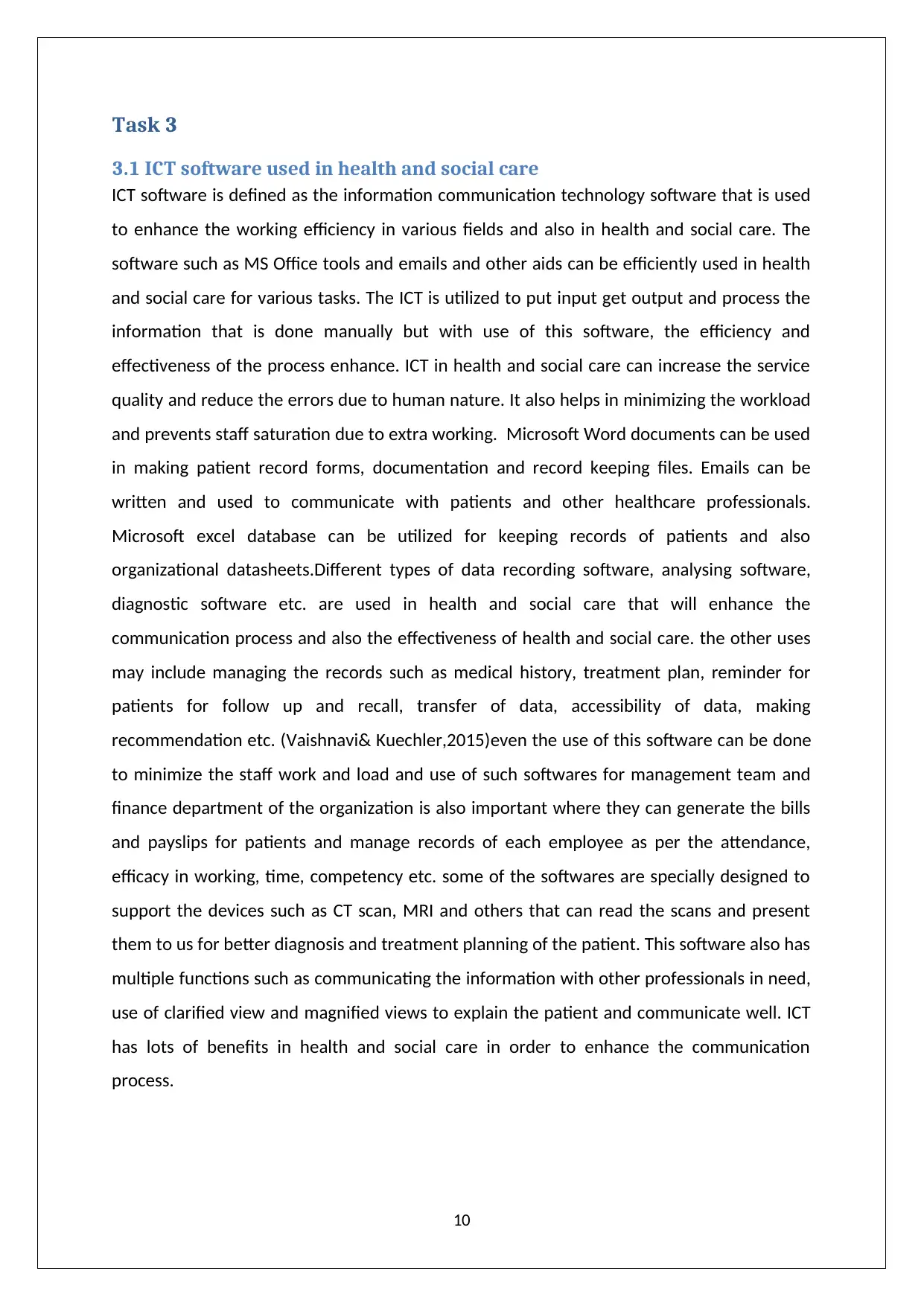
Task 3
3.1 ICT software used in health and social care
ICT software is defined as the information communication technology software that is used
to enhance the working efficiency in various fields and also in health and social care. The
software such as MS Office tools and emails and other aids can be efficiently used in health
and social care for various tasks. The ICT is utilized to put input get output and process the
information that is done manually but with use of this software, the efficiency and
effectiveness of the process enhance. ICT in health and social care can increase the service
quality and reduce the errors due to human nature. It also helps in minimizing the workload
and prevents staff saturation due to extra working. Microsoft Word documents can be used
in making patient record forms, documentation and record keeping files. Emails can be
written and used to communicate with patients and other healthcare professionals.
Microsoft excel database can be utilized for keeping records of patients and also
organizational datasheets.Different types of data recording software, analysing software,
diagnostic software etc. are used in health and social care that will enhance the
communication process and also the effectiveness of health and social care. the other uses
may include managing the records such as medical history, treatment plan, reminder for
patients for follow up and recall, transfer of data, accessibility of data, making
recommendation etc. (Vaishnavi& Kuechler,2015)even the use of this software can be done
to minimize the staff work and load and use of such softwares for management team and
finance department of the organization is also important where they can generate the bills
and payslips for patients and manage records of each employee as per the attendance,
efficacy in working, time, competency etc. some of the softwares are specially designed to
support the devices such as CT scan, MRI and others that can read the scans and present
them to us for better diagnosis and treatment planning of the patient. This software also has
multiple functions such as communicating the information with other professionals in need,
use of clarified view and magnified views to explain the patient and communicate well. ICT
has lots of benefits in health and social care in order to enhance the communication
process.
10
3.1 ICT software used in health and social care
ICT software is defined as the information communication technology software that is used
to enhance the working efficiency in various fields and also in health and social care. The
software such as MS Office tools and emails and other aids can be efficiently used in health
and social care for various tasks. The ICT is utilized to put input get output and process the
information that is done manually but with use of this software, the efficiency and
effectiveness of the process enhance. ICT in health and social care can increase the service
quality and reduce the errors due to human nature. It also helps in minimizing the workload
and prevents staff saturation due to extra working. Microsoft Word documents can be used
in making patient record forms, documentation and record keeping files. Emails can be
written and used to communicate with patients and other healthcare professionals.
Microsoft excel database can be utilized for keeping records of patients and also
organizational datasheets.Different types of data recording software, analysing software,
diagnostic software etc. are used in health and social care that will enhance the
communication process and also the effectiveness of health and social care. the other uses
may include managing the records such as medical history, treatment plan, reminder for
patients for follow up and recall, transfer of data, accessibility of data, making
recommendation etc. (Vaishnavi& Kuechler,2015)even the use of this software can be done
to minimize the staff work and load and use of such softwares for management team and
finance department of the organization is also important where they can generate the bills
and payslips for patients and manage records of each employee as per the attendance,
efficacy in working, time, competency etc. some of the softwares are specially designed to
support the devices such as CT scan, MRI and others that can read the scans and present
them to us for better diagnosis and treatment planning of the patient. This software also has
multiple functions such as communicating the information with other professionals in need,
use of clarified view and magnified views to explain the patient and communicate well. ICT
has lots of benefits in health and social care in order to enhance the communication
process.
10
Paraphrase This Document
Need a fresh take? Get an instant paraphrase of this document with our AI Paraphraser
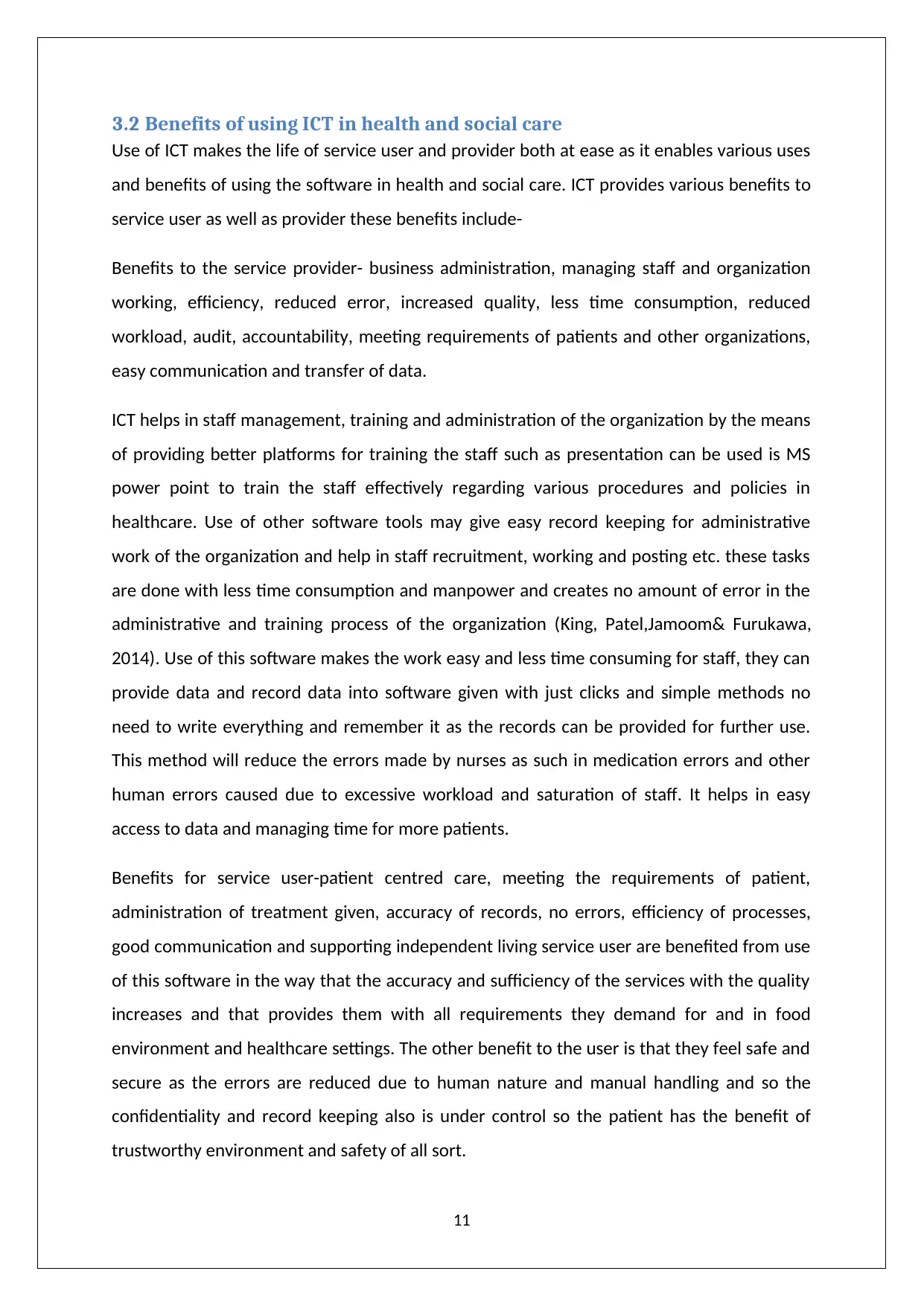
3.2 Benefits of using ICT in health and social care
Use of ICT makes the life of service user and provider both at ease as it enables various uses
and benefits of using the software in health and social care. ICT provides various benefits to
service user as well as provider these benefits include-
Benefits to the service provider- business administration, managing staff and organization
working, efficiency, reduced error, increased quality, less time consumption, reduced
workload, audit, accountability, meeting requirements of patients and other organizations,
easy communication and transfer of data.
ICT helps in staff management, training and administration of the organization by the means
of providing better platforms for training the staff such as presentation can be used is MS
power point to train the staff effectively regarding various procedures and policies in
healthcare. Use of other software tools may give easy record keeping for administrative
work of the organization and help in staff recruitment, working and posting etc. these tasks
are done with less time consumption and manpower and creates no amount of error in the
administrative and training process of the organization (King, Patel,Jamoom& Furukawa,
2014). Use of this software makes the work easy and less time consuming for staff, they can
provide data and record data into software given with just clicks and simple methods no
need to write everything and remember it as the records can be provided for further use.
This method will reduce the errors made by nurses as such in medication errors and other
human errors caused due to excessive workload and saturation of staff. It helps in easy
access to data and managing time for more patients.
Benefits for service user-patient centred care, meeting the requirements of patient,
administration of treatment given, accuracy of records, no errors, efficiency of processes,
good communication and supporting independent living service user are benefited from use
of this software in the way that the accuracy and sufficiency of the services with the quality
increases and that provides them with all requirements they demand for and in food
environment and healthcare settings. The other benefit to the user is that they feel safe and
secure as the errors are reduced due to human nature and manual handling and so the
confidentiality and record keeping also is under control so the patient has the benefit of
trustworthy environment and safety of all sort.
11
Use of ICT makes the life of service user and provider both at ease as it enables various uses
and benefits of using the software in health and social care. ICT provides various benefits to
service user as well as provider these benefits include-
Benefits to the service provider- business administration, managing staff and organization
working, efficiency, reduced error, increased quality, less time consumption, reduced
workload, audit, accountability, meeting requirements of patients and other organizations,
easy communication and transfer of data.
ICT helps in staff management, training and administration of the organization by the means
of providing better platforms for training the staff such as presentation can be used is MS
power point to train the staff effectively regarding various procedures and policies in
healthcare. Use of other software tools may give easy record keeping for administrative
work of the organization and help in staff recruitment, working and posting etc. these tasks
are done with less time consumption and manpower and creates no amount of error in the
administrative and training process of the organization (King, Patel,Jamoom& Furukawa,
2014). Use of this software makes the work easy and less time consuming for staff, they can
provide data and record data into software given with just clicks and simple methods no
need to write everything and remember it as the records can be provided for further use.
This method will reduce the errors made by nurses as such in medication errors and other
human errors caused due to excessive workload and saturation of staff. It helps in easy
access to data and managing time for more patients.
Benefits for service user-patient centred care, meeting the requirements of patient,
administration of treatment given, accuracy of records, no errors, efficiency of processes,
good communication and supporting independent living service user are benefited from use
of this software in the way that the accuracy and sufficiency of the services with the quality
increases and that provides them with all requirements they demand for and in food
environment and healthcare settings. The other benefit to the user is that they feel safe and
secure as the errors are reduced due to human nature and manual handling and so the
confidentiality and record keeping also is under control so the patient has the benefit of
trustworthy environment and safety of all sort.
11
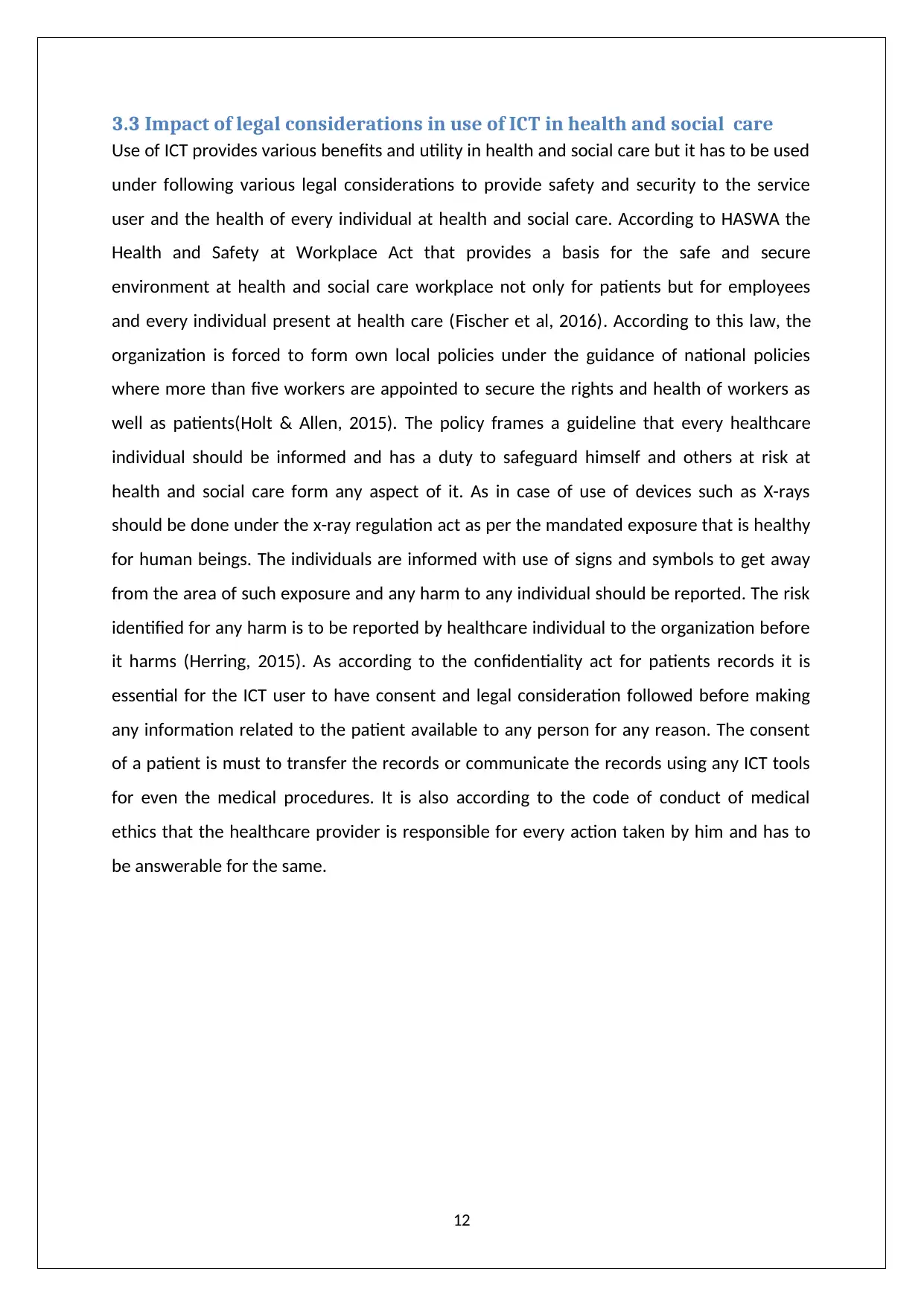
3.3 Impact of legal considerations in use of ICT in health and social care
Use of ICT provides various benefits and utility in health and social care but it has to be used
under following various legal considerations to provide safety and security to the service
user and the health of every individual at health and social care. According to HASWA the
Health and Safety at Workplace Act that provides a basis for the safe and secure
environment at health and social care workplace not only for patients but for employees
and every individual present at health care (Fischer et al, 2016). According to this law, the
organization is forced to form own local policies under the guidance of national policies
where more than five workers are appointed to secure the rights and health of workers as
well as patients(Holt & Allen, 2015). The policy frames a guideline that every healthcare
individual should be informed and has a duty to safeguard himself and others at risk at
health and social care form any aspect of it. As in case of use of devices such as X-rays
should be done under the x-ray regulation act as per the mandated exposure that is healthy
for human beings. The individuals are informed with use of signs and symbols to get away
from the area of such exposure and any harm to any individual should be reported. The risk
identified for any harm is to be reported by healthcare individual to the organization before
it harms (Herring, 2015). As according to the confidentiality act for patients records it is
essential for the ICT user to have consent and legal consideration followed before making
any information related to the patient available to any person for any reason. The consent
of a patient is must to transfer the records or communicate the records using any ICT tools
for even the medical procedures. It is also according to the code of conduct of medical
ethics that the healthcare provider is responsible for every action taken by him and has to
be answerable for the same.
12
Use of ICT provides various benefits and utility in health and social care but it has to be used
under following various legal considerations to provide safety and security to the service
user and the health of every individual at health and social care. According to HASWA the
Health and Safety at Workplace Act that provides a basis for the safe and secure
environment at health and social care workplace not only for patients but for employees
and every individual present at health care (Fischer et al, 2016). According to this law, the
organization is forced to form own local policies under the guidance of national policies
where more than five workers are appointed to secure the rights and health of workers as
well as patients(Holt & Allen, 2015). The policy frames a guideline that every healthcare
individual should be informed and has a duty to safeguard himself and others at risk at
health and social care form any aspect of it. As in case of use of devices such as X-rays
should be done under the x-ray regulation act as per the mandated exposure that is healthy
for human beings. The individuals are informed with use of signs and symbols to get away
from the area of such exposure and any harm to any individual should be reported. The risk
identified for any harm is to be reported by healthcare individual to the organization before
it harms (Herring, 2015). As according to the confidentiality act for patients records it is
essential for the ICT user to have consent and legal consideration followed before making
any information related to the patient available to any person for any reason. The consent
of a patient is must to transfer the records or communicate the records using any ICT tools
for even the medical procedures. It is also according to the code of conduct of medical
ethics that the healthcare provider is responsible for every action taken by him and has to
be answerable for the same.
12
⊘ This is a preview!⊘
Do you want full access?
Subscribe today to unlock all pages.

Trusted by 1+ million students worldwide
1 out of 15
Related Documents
Your All-in-One AI-Powered Toolkit for Academic Success.
+13062052269
info@desklib.com
Available 24*7 on WhatsApp / Email
![[object Object]](/_next/static/media/star-bottom.7253800d.svg)
Unlock your academic potential
Copyright © 2020–2025 A2Z Services. All Rights Reserved. Developed and managed by ZUCOL.





